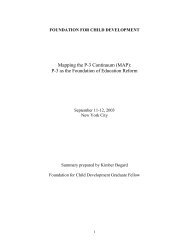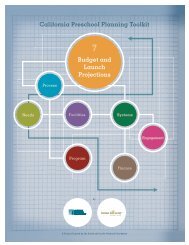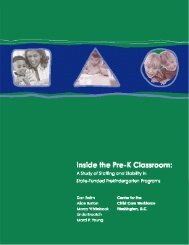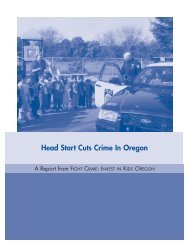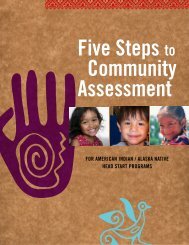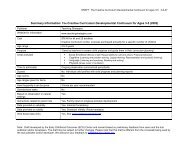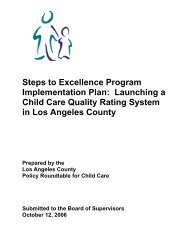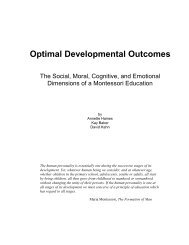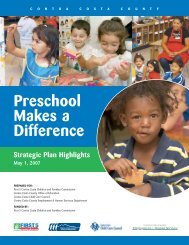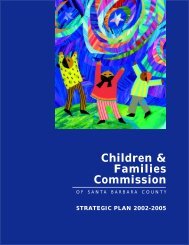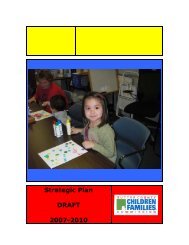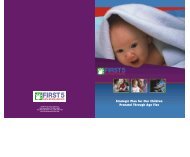Download this file - Plan4Preschool
Download this file - Plan4Preschool
Download this file - Plan4Preschool
Create successful ePaper yourself
Turn your PDF publications into a flip-book with our unique Google optimized e-Paper software.
• Number of libraries. Among California public schools, 99 percent have a place<br />
designated as the library, although staffing, collections, and programs range from<br />
exemplary to substandard.<br />
• Staffing. Approximately 23 percent of California schools have a credentialed<br />
library media teacher on campus part time or longer; the majority of professional<br />
staffing is found at the high school level. A library media teacher has both a<br />
California teaching credential and a California library media teacher services<br />
credential. Although the average national ratio of library media teachers to<br />
students in the fall of 2002 was 1:889, California ranks fifty-first in the nation with a<br />
current ratio of 1:5,965 (2004-05 CBEDS Report and Digest of Education<br />
Statistics Tables and Figures, National Center for Education Statistics, 2005,<br />
http://nces.ed.gov/programs/digest/d05_tf.asp). In 2004-05, 90 percent of the<br />
schools reported classified staff in the library.<br />
• Library books. The latest figure for the average number of school library books<br />
per kindergarten through grade twelve (K–12) student in California is 17.2. In 1986<br />
the number reported per student was ten. Nationally, school libraries average 22<br />
books per student.<br />
• Age of collection. The age of the library books is as important as the number of<br />
books available to students. In 1995 the average copyright date of a California<br />
school library nonfiction book was 1972. In 2004-05 the average copyright date<br />
rose to 1993. For a current chart of the number and age of California school library<br />
books, visit the School Library Web site at http://www.cde.ca.gov/ci/cr/lb.<br />
• Book costs. The average cost of a children’s and young adult hardcover book in<br />
2005 was $20.52, an increase of $1.21 over the 2004 average. Annual School<br />
Library Journal reports indicate that over the last five years, the average book<br />
price has increased by 14.4 percent. For a chart comparing the average cost of a<br />
children’s and young adult’s book with the state funding for school libraries, visit<br />
the School Library Web site at http://www.cde.ca.gov/ci/cr/lb.<br />
• Funding. The primary source of library funding for 54 percent of California<br />
schools is still the California Public School Library Act of 1998, a categorical<br />
program that ended in 2004-05. Fundraising activities provide the second-most<br />
important source of funding.<br />
• Electronic access to resources. Ninety percent of the 5,652 responding school<br />
libraries reported the use of an electronic catalog and automated circulation<br />
system. Seventy-nine percent reported providing access to the Internet. Internet<br />
access increases with grade levels: 74 percent of school libraries reported offering<br />
access at the elementary school level, 95 percent at the middle school level, and<br />
99 percent at the high school level (CDE Online School Library Survey for<br />
2004-05).<br />
• Need for books. The Internet does not replace the need for books and often<br />
increases the demand for up-to-date library materials. Library resources come in<br />
various formats—both print and electronic—and are selected based on the best<br />
format for the intended user and use.<br />
• Library hours. The average number of hours that a California school library is<br />
open to students is 28 hours per week. Seventy-six percent of school libraries<br />
reported being open during breaks, 70 percent during lunch, and 59 percent<br />
105



